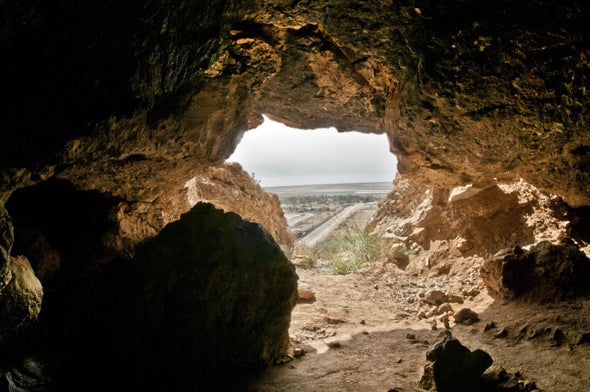(单词翻译:单击)
听力文本
This is Scientific American's 60-second Science, I'm Christopher Intagliata.
The Dead Sea Scrolls are religious manuscripts that were written from the third century B.C.E. to the first century C.E. They were discovered in the 1940s and '50s in caves along the shore of the Dead Sea. The parchments have been the topic of intense religious, literary and historical debate. They also continue to be the subject of scientific analysis—including DNA.
"The idea was to try to match and piece apart fragments based on their genetic identity—namely based on the animals from which they were made."
Oded Rechavi is a molecular biologist Tel Aviv University. His team sequenced the DNA from bits of scroll dust.
"Almost all the scrolls we sampled were perhaps surprisingly found to be made out of sheep skin. We found two that were made out of cow skin, that is a big story."
Here Rechavi's colleague Noam Mizrahi from the university's department of biblical studies picked up the story. The scrolls, he says, came from a place called Qumran, a three day's walk from the cultural center of Jerusalem. Mizrahi explains that the people of Qumran were an extremist group, with apocalyptic predictions, who harshly criticized the views of others.

Therefore, he says, there's been long-standing debate about how much the scrolls—unearthed from this sect in Qumran—represented just this faction's views or more general Jewish thought at the time. The presence of cow skins in a desert region, inhospitable to cattle, is provocative because it suggests this...
"Cow-made scrolls do not reflect the sectarian community of Qumran but were rather brought from the outside, written at the outside—and hence reflect broader Jewish society of the period."
That finding is in the journal Cell. Several other lines of evidence point to the ancient Qumran library containing a broad diversity of texts.
Mizrahi says genetics have added a new dimension to his studies, complementing his analysis of the content and language of the parchments.
"Here I discovered that the material of the scrolls, the very biological material from which the scrolls are made, is as informative and as telling in terms of the very question that was trying to clarify for myself and for other scholars."
In other words, sometimes you need the subtext—in this case, literally the material under the writing.
Thanks for listening for Scientific American's 60-second Science. I'm Christopher Intagliata.
参考译文
这里是科学美国人——60秒科学系列,我是克里斯托弗·因塔格里塔。
《死海古卷》是从公元前3世纪到公元前1世纪写成的宗教手稿。这些手稿于上世纪40年代和50年代在死海沿岸的洞穴中被发现。这些羊皮纸手稿一直是宗教、文学和历史领域激烈争论的话题。它们也继续成为包括DNA在内的科学分析的对象。
“我们的想法是根据碎片的基因身份,即根据其是什么动物做的,来将其匹配和拼凑起来。”
特拉维夫大学的分子生物学家奥德·雷查维说到。他的团队对卷轴上的尘埃微粒进行了DNA测序。
“令人惊讶的是,我们抽样的几乎所有卷轴都由羊皮制成。我们发现了两件牛皮卷轴,这相当重要。”
与雷查维同校的圣经研究院的诺姆·米兹莱希从这里接手这个项目。他表示,这些卷轴来自昆兰,这个地方离耶路撒冷文化中心有三天的步行距离。米兹莱希解释说,昆兰人是相信末日预言的极端组织,他们会严厉批评其他人的观点。
因此,他认为存在一种长期的争论,即从昆兰这一教派地区出土的卷轴在多大程度上只代表这个教派的观点或当时更普遍的犹太人思想?在对牛不友好的沙漠地区出现牛皮是种挑衅,因为它表明……
“牛皮卷轴并不反映昆兰教派群体,而是在外地书写并带入该地区,因此反映的是当时更广泛的犹太社会。”
这项研究发表在《细胞》期刊上。其他几项证据表明,古昆兰图书馆包含了广泛多样的文本。
米兹莱希表示,遗传学为他的研究增加了新维度,补充了他对羊皮纸文稿内容和语言的分析。
“我发现,就努力为自已和其他学者解释卷轴这件事而言,卷轴的材料,也就是制作卷轴所用的生物材料,既具有信息价值,又具有说服力。”
换句话说,有时你需要潜台词——就此案例而言,指的就是文字下面的材料。
谢谢大家收听科学美国人——60秒科学。我是克里斯托弗·因塔利亚塔。
译文为可可英语翻译,未经授权请勿转载!
重点讲解
重点讲解:
1. be made out of (由…)构成的;(由…)制成的;
It was made out of a special lightweight alloy.
它用一种特殊的轻型合金制成。
2. be inhospitable to 不好客的;不友好的;
It is inhospitable to turn a stranger away.
把陌生人拒之门外不是好客的表现。
3. point to 显示;表明;
Earlier reports pointed to pupils working harder, more continuously, and with enthusiasm.
早些时候的报告显示学生学习更为刻苦、持久,并且怀有学习热情。
4. add to 增添;增加;
Her job added a new dimension to her life.
她的工作为她的生活增添了新的内容。


